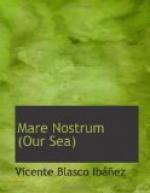Sometimes he would go to see how the repairs were getting on in his boat,—an excellent pretext for venting his wrath on somebody. On other mornings he would go to the garden of the beach of Chiaja,—to the very same places through which he had strolled with Freya. He was always looking for her to appear from one moment to another. Everything ’round about suggested some reminder of her. Trees and benches, pavements and electric lights knew her perfectly because of having formed a part of her regular walk.
Becoming convinced that he was waiting in vain, a last hope made him glance toward the white building of the Aquarium. Freya had frequently mentioned it. She was accustomed to amuse herself, oftentimes passing entire hours there, contemplating the life of the inhabitants of the sea. And Ferragut blinked involuntarily as he passed rapidly from the garden boiling under the sun into the shadow of the damp galleries with no other illumination than that of the daylight which penetrated to the interior of the Aquarium,—a light that, seen through the water and the glass, took on a mysterious tone, the green and diffused tint of the subsea depths.
This visit enabled him to kill time more placidly. There came to his mind old readings confirmed now by direct vision. He was not the kind of sailor that sails along regardless of what exists under his keel. He wanted to know the mysteries of the immense blue palace over whose roof he was usually navigating, devoting himself to the study of oceanography, the most recent of sciences.
Upon taking his first steps in the Aquarium, he immediately pictured the marine depths which exploration had divided and charted so unequally. Near the shores, in the zone called “the littoral” where the rivers empty, the materials of nourishment were accumulated by the impulse of the tides and currents, and there flourished sub-aquatic vegetation. This was the zone of the great fish and reached down to within two hundred fathoms of the bottom,—a depth to which the sun’s rays never penetrate. Beyond that there was no light; plant life disappeared and with it the herbivorous animals.
The submarine grade, a gentle one down to this point, now becomes very steep, descending rapidly to the oceanic abysses,—that immense mass of water (almost the entire ocean), without light, without waves, without tides, without currents, without oscillations of temperature, which is called the “abyssal” zone.
In the littoral, the waters, healthfully agitated, vary in saltiness according to the proximity of the rivers. The rocks and deeps are covered with a vegetation which is green near the surface, becoming darker and darker, even turning to a dark red and brassy yellow as it gets further from the light. In this oceanic paradise of nutritive and luminous waters charged with bacteria and microscopic nourishment, life is developed in exuberance. In spite of the continual traps of the fishermen, the marine herds keep themselves intact because of their infinite powers of reproduction.




